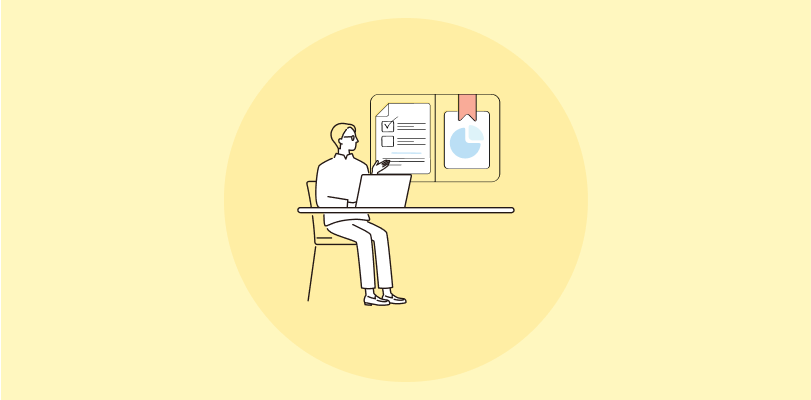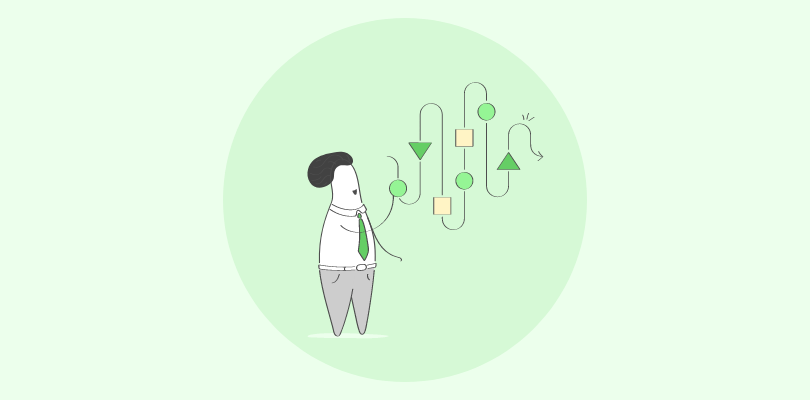Would it jolt you if I told you there are more than 20 different types of eLearning content?
You know that new and exciting experiences make life more interesting.
The same holds true for eLearning. Understanding the significance of and implementing the different eLearning content types can make learning inclusive and impactful.
If you’re ready to reap the benefits of this online learning strategy, continue reading.
Here’s a list of the forms of eLearning commonly used by educators and corporate trainers.
What Is eLearning Content?
eLearning content refers to the materials or resources that are designed and used for online education and training. It comes in various formats such as text, images, videos, interactive simulations, quizzes, and games accessible through a learning management system (LMS) or an online learning platform over the internet.
Learners can access and engage with the content at their own pace and convenience, without the need for physical presence in a traditional classroom setting.
Essentially, eLearning content is the digital version of conventional educational materials.
Key Elements of Effective eLearning Content
While creating eLearning content, you should consider several key elements to make it suitable for diverse learning styles, ensure engagement, and facilitate knowledge retention.
Here’s an overview of those elements:
- Clear Learning Objectives: Before designing a course or other content type, define what learners should know or be able to do by the end of the course. Clear and measurable learning objectives guide the development of content and assessments.
- Interactive & Engaging Material: Interactive elements like quizzes, simulations, and videos keep learners engaged and allow them to apply concepts as they learn. This interactivity enhances learning by making it active rather than passive.
- Multimedia Use: A mix of text, images, videos, and audio caters to different learning styles and helps in better understanding and retention of information. Videos and animations can be particularly effective in explaining complex concepts.
- Accessibility and Usability: Content should be accessible to all learners, including those with disabilities. This includes designing content that is compatible with screen readers, providing captions for videos, and ensuring that navigation is straightforward and intuitive.
- Modular Structure: Breaking down content into smaller, manageable modules or chunks helps in better absorption of information. This also allows learners to navigate through the course easily and learn at their own pace.
- Real-World Relevance: Connecting theory to real-world applications enhances the relevance and motivates learners to engage with the content. Case studies, scenarios, and examples from the industry make learning more applicable to real-life situations.
- Feedback and Assessment: Providing timely and constructive feedback through quizzes, assignments, and assessments helps learners gauge their understanding and apply knowledge. Formative assessments throughout an eLearning program can guide learners on their progress.
- Collaborative Learning Opportunities: Encourage collaboration through forums, group projects, and peer reviews to foster a learning community, enhance problem-solving skills, and facilitate knowledge sharing.
- Adaptability and Personalization: Offer learners the chance to personalize their learning paths based on their knowledge level, interests, progress, and goals. This enhances engagement and effectiveness. Adaptive learning technologies can tailor content and assessments to a learner’s performance.
- Continuous Evaluation and Update: eLearning content should be regularly reviewed and updated to ensure it remains current and relevant. Feedback from learners and advancements in the subject area should guide updates.
- Technical Quality: Ensure high-quality graphics, audio, and video for a professional and engaging learning experience. Poor technical quality can distract from the learning content and hinder engagement.
16 Popular Types of eLearning Content
Now that you know what eLearning content is and its key elements, let’s explore the popular eLearning content types. In my role as an eLearning professional, I often work with these content varieties.
- Online Courses
- Training Videos
- Podcasts
- eLearning Games
- Role Plays
- Problem/Solution Scenarios
- Case Studies
- Quizzes
- Assessments
- White Papers
- Dialogue simulations
- eBooks
- VR & AR
- Webinars
- Slide Presentations
- Infographics
Let me elaborate on each of them.
1. Online Courses
Online courses are one of the most accepted and widely used types of eLearning content. This mode of learning has gained significant popularity due to its flexibility, accessibility, and the diverse range of subjects it can cover.
Generally, online courses are delivered and accessed through digital platforms. Some of the top-rated cloud LMS provide professionally designed, fully customizable, and ready-to-use courses for faster eLearning implementation.
These courses are structured programs designed to deliver comprehensive knowledge on a specific subject. Also, they often include a series of lessons or modules, videos, quizzes, and final assessments.
The best part is online courses can be self-paced and they offer certification upon completion.
2. Training Videos
A majority of people are visual learners, and when visuals are combined with well-structured narratives, it can boost learning retention rates by a much higher margin over text-based materials.
Video-based content is the new standard for online training and education. It involves delivering information through videos, whether as recorded lectures, tutorials, demonstrations, or presentations.
Here’s an example:

You can deploy training videos as a standalone element or embed them in a course.
By providing audiovisual experiences, videos increase learner engagement and retention. They can be used to explain procedures, teach concepts, and provide examples in a way that is engaging and easy to understand.
3. Podcasts
There are 504.9 million podcast listeners worldwide. It is equivalent to 23.5% of all internet users.

As an eLearning content type, audio recordings or podcasts are getting popular by the day. They focus on a particular topic or subject and enable learners to absorb information without needing to watch or read content actively.
In other words, they are suitable for learning on the go. Learners can listen to them while driving, standing in a queue, or just relaxing on a couch.
Podcasts are increasingly being recognized as a valuable medium for eLearning and online training. They require less budget and development time than videos, and they can be leveraged at all stages of learning.
Also, user-generated podcasts encourage the sharing of experiences and knowledge among learners, fostering a community of learning.
4. eLearning Games
This type of eLearning content incorporates game-like elements to make learning more engaging and interactive. It often includes badges, points, leaderboards, and rewards to encourage participation and progress.

Gamified content has become one of the most in-demand eLearning content types due to increased engagement and improved motivation.
Learners also receive immediate feedback on their actions so they know what and how to adjust to improve their performance.
Similarly, gamification speaks the language of modern learners and this makes learning more relevant and appealing to them.
5. Role Plays
Role plays are significant as a type of eLearning content used in online learning or training scenarios. Here’s why:
- Role plays encourage active participation, engagement, and learning.
- They provide a safe environment for learners to practice and develop core skills.
- Learners get the opportunity to experience different roles and perspectives by stepping outside their comfort zones.
- They bridge the gap between theory and practice.
- Through role plays, learners gain confidence by practicing and honing their skills in a realistic setting.
- Such group activities foster teamwork and collaboration among learners.
Look at the following example of a role play during employee training to appreciate their importance better:
Scenario: Customer Service Training
Characters:
- Trainer (T)
- Trainee (Tr)
- Angry Customer (AC)
Trainer’s Instructions: The trainee will play the role of a customer service representative, and the trainer will act as an angry customer. The objective of the role play is to demonstrate effective handling of an irate customer complaint.
Role Play:
T: Good morning. Thank you for calling our customer service hotline. How may I assist you today?
AC: (Agitated) I am extremely disappointed with your company’s product. I purchased it a week ago, and it’s already malfunctioning. I want a refund immediately!
Tr: I apologize for the inconvenience you’re facing, sir. I understand your frustration. Let me assure you that we take product quality very seriously. May I have your order number and some details about the issue you’re experiencing?
AC: Order number? I don’t have it right now. It’s ridiculous that I have to go through all this hassle just to get a refund!
Tr: I completely understand your frustration, sir. However, having your order number will help me investigate the issue more efficiently and ensure a prompt resolution. If you can provide any other relevant information, I will try my best to assist you further.
AC: Fine! The product is an XYZ model, and it’s not working as advertised. It keeps shutting down randomly.
Tr: Thank you for the information. I apologize for the inconvenience caused by the product’s performance. To resolve this issue, I suggest performing a few troubleshooting steps. If that doesn’t work, we can discuss the possibility of a refund or exchange. Can you please try rebooting the device and let me know if there’s any improvement?
AC: (Calming down slightly) Alright, I’ll give it a try. But I expect a quick resolution!
Tr: I completely understand, sir. I appreciate your cooperation. If the issue persists even after trying the troubleshooting steps, please reach out to me again, and we’ll explore further options to resolve this matter to your satisfaction.
End of Role Play
In this example, the role play simulates a customer service representative handling an angry customer. It demonstrates effective communication, empathy, and problem-solving skills to de-escalate the situation and find a solution that suits the customer’s needs. The trainer can provide feedback on the trainee’s performance to help improve their customer service skills.
6. Problem/Solution Scenarios
In a problem/solution scenario, learners are presented with a problem, and they are expected to use the skills they’ve learned to find a solution.
This is an opportunity for them to showcase comprehension of the material they’ve learned.
Such situations develop the critical-thinking skills in participants. For positive outcomes, make sure the problem is realistic and relatable.
Alternatively, you may ask the learners to think up a problem that they’ve experienced themselves in the past.
Problem/solution scenarios provide opportunities for animated discussion and implementation of best practices.
7. Case Studies
Case studies are another invaluable type of eLearning content. They provide a real-world context to theoretical knowledge and bridge the gap between concepts and how these concepts are applied in practical scenarios.
Here’s how case studies function within eLearning and how training managers, teachers, and instructors utilize them:
- Real-life application to see the relevance of what learners are learning.
- Critical thinking and problem-solving to propose solutions to complex problems.
- Case studies use storytelling to convey complex information in a simple way.
You can select or tailor case studies to match the specific learning objectives of your programs. Case studies can also be used as a basis for assessments and feedback.
By integrating case studies into eLearning programs, you can enhance the learning experience, make it more impactful, and align with the learners’ professional development goals.
8. Quizzes
Online quizzes serve as a vital component of eLearning content. They are mainly designed to assess the understanding, retention, and recall capacity of learners following a program.
They inject a fun element into online learning as most quizzes are kept short and can be attempted quickly.
By challenging learners to apply what they have learned, quizzes enhance the ability to master a subject matter.
Additionally, quizzes offer instructors valuable insights into learners’ progress and areas that may require further clarification or emphasis. This interactive element encourages active participation and motivates learners to achieve better.
Learners can also receive immediate feedback on their performance through automatic scoring and grading.
9. Assessments
Like quizzes, assessments play a crucial role in eLearning by serving as a tool for measuring learners’ understanding and progress and as a means to reinforce learning.
But assessments are broader in scope and are designed to evaluate a learner’s comprehensive understanding, skills, abilities, and progress in a subject or course. They can be formative or summative in nature.
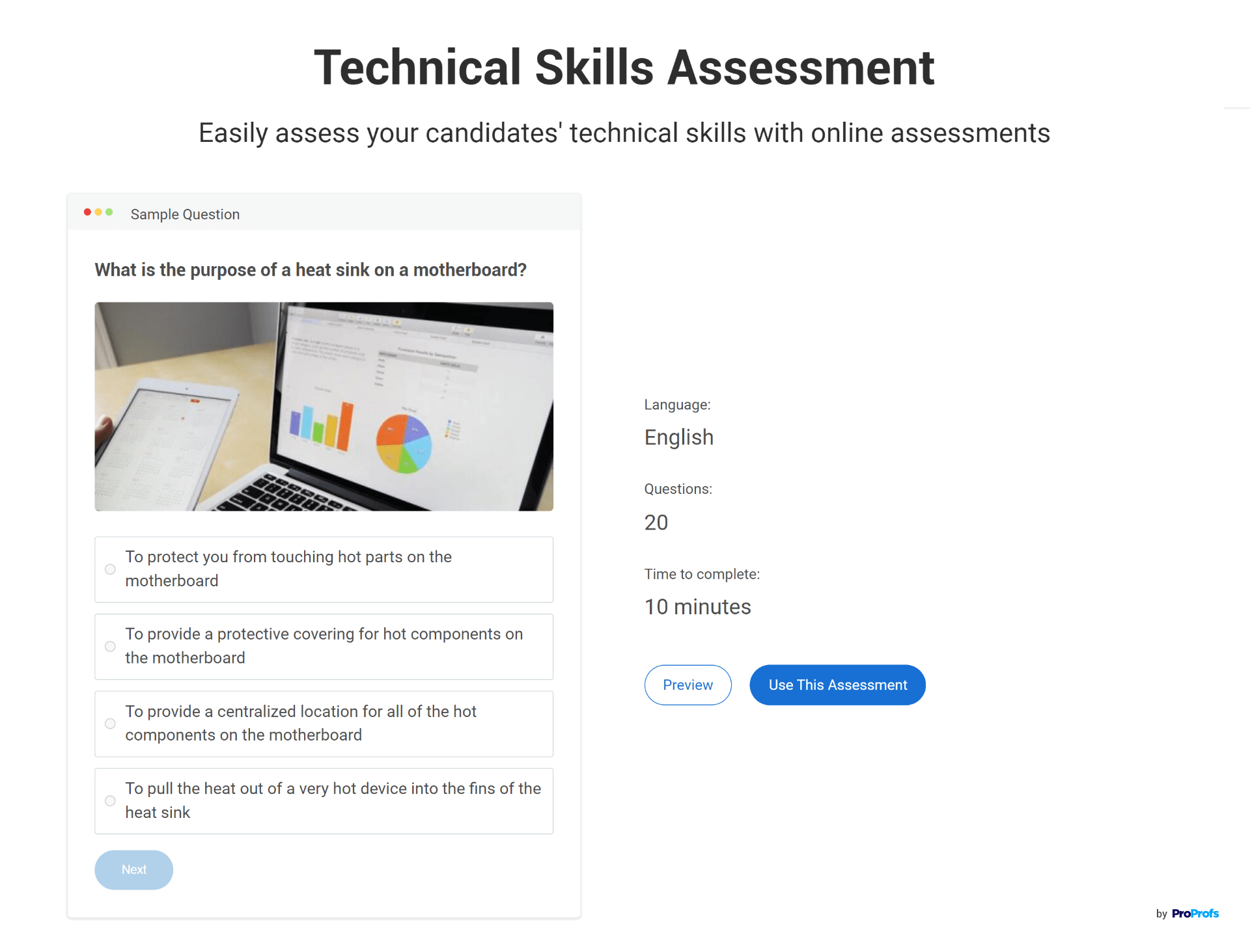
Assessments not only enable learners to assess their own knowledge and skills, but also enable instructors to evaluate the effectiveness of eLearning programs and make necessary adjustments to improve the learning experience.
By incorporating assessments into eLearning content, learners are supported in their active engagement and understanding of the material while instructors can monitor milestones and setbacks along the way.
10. White Papers
A white paper is a detailed guide or report that informs readers concisely about a complex issue and presents the issuing body’s philosophy on the matter. It is meant to help readers understand an issue, solve a problem, or make a decision.
In the context of eLearning, white papers serve several important functions as an educational tool, thought leadership, problem-solving guides, marketing and promotion, and engagement and discussion starters.
They serve as authoritative content that educates, informs, and influences readers, while also helping to advance knowledge and practices in the field of eLearning. They are a key resource for anyone looking to deepen their understanding of specific eLearning topics or to stay updated on the latest trends and research findings.
11. Dialogue Simulations
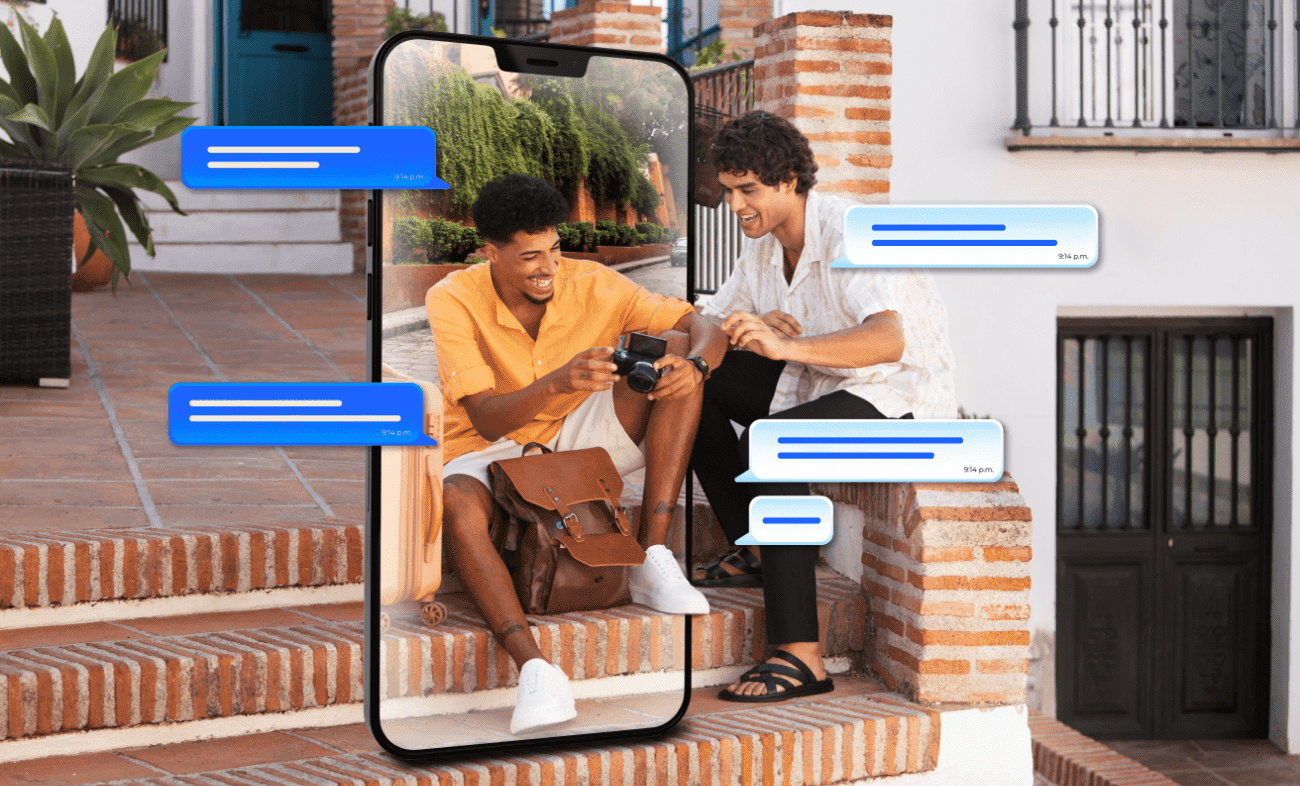
A simulated dialogue is a type of eLearning material designed to mimic an authentic interaction with a customer or external party. This format is highly effective for instructing on customer service and sales techniques, as well as any training situation requiring a conversational exchange.
Effective dialogue simulations often incorporate branching scenarios, in which the choices made by an employee lead to various consequences and influence both the results and subsequent phases of the simulation.
12. eBooks

eBooks make good eLearning content for several reasons. They are often used as supplementary materials in various courses.
They can be easily accessed and downloaded from various platforms.
Many eBook platforms provide interactive features, , such as embedded videos, quizzes, and exercises, that enhance the learning experience.
eBooks are lightweight and can be stored on a single device. They often have search functions and easy-to-use navigation tools, enabling learners to find the information they need quickly.
You can customize eBooks by adding your own content and design to meet the specific needs of learners.
Also, they usually cost less than physical textbooks or classroom materials. They can be downloaded at a fraction of the cost, or sometimes even offered for free.
13. VR & AR
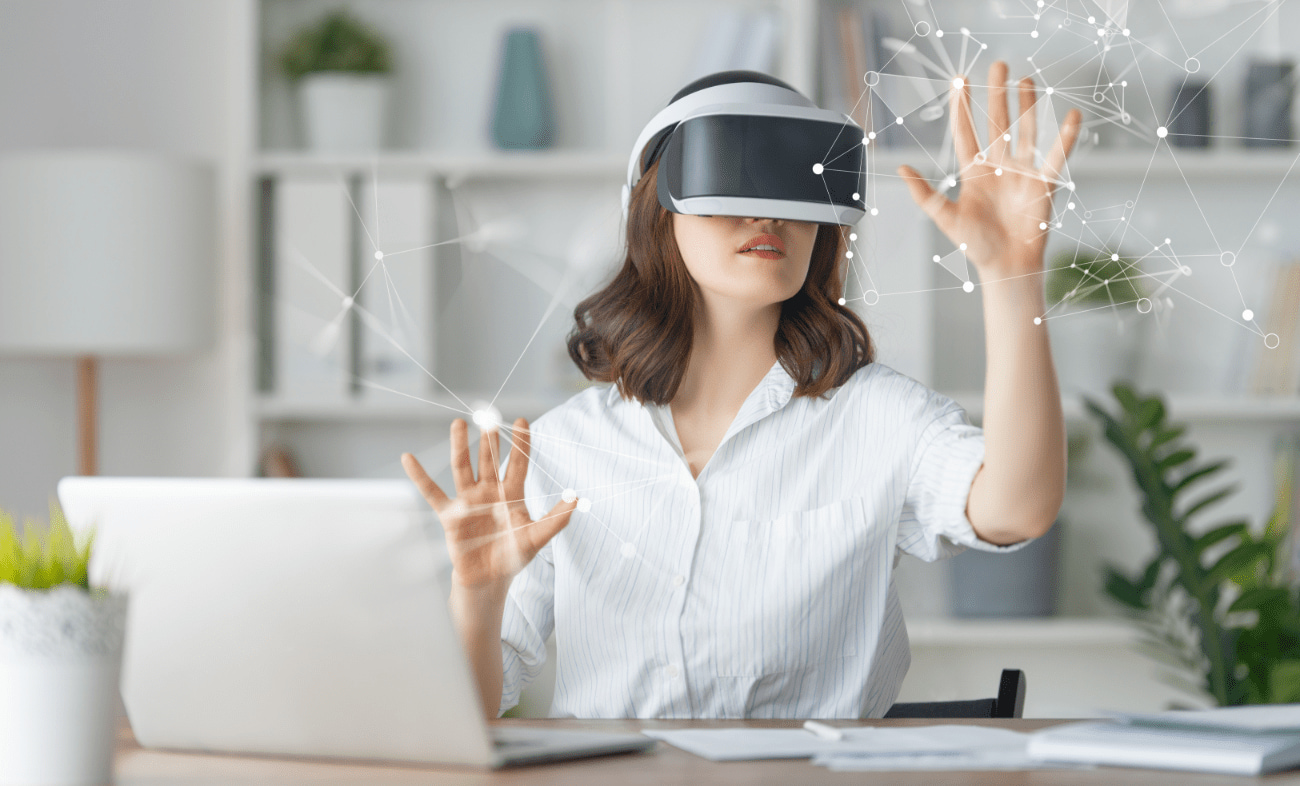
Virtual reality (VR) and augmented reality (AR) are becoming popular tools in the eLearning industry primarily because of their immersive and interactive nature. These technologies can enhance engagement, retention, and understanding of complex concepts.
Some of the use cases of VR and AR in eLearning are:
- Virtual field trips to historical sites, different countries, or even inside the human body.
- Realistic simulations to practice real-world skills in a safe environment. For instance, medical students can perform virtual surgeries, or employees can practice operating machinery.
- AR can overlay information or instructions onto physical products to help employees receive on-the-job training.
- AR apps can overlay translations or pronunciation guides onto real-world objects to make language learning more effective.
- VR can be used to simulate dangerous situations or emergencies to train employees in proper safety protocols without any real-world risks.
These are just a few examples of how VR and AR are revolutionizing the eLearning industry by providing innovative and interactive content to learners.
14. Webinars

Webinars are live online seminars or workshops conducted over the internet where an instructor or expert discusses a topic in real-time. They support interactions with participants through Q&A sessions, polls, and discussions.
They are designed to replicate the experience of traditional seminars or workshops in an online environment. This synchronous aspect of webinars sets them apart from other eLearning materials, such as pre-recorded video courses or written content.
The immediacy associated with webinars fosters a more engaging learning experience.
Moreover, you can record webinars and provide asynchronous access to learners who wish to revisit the content or who are unable to attend the live session.
The effectiveness of webinars in online education and training stems from their ability to combine visual, auditory, and kinesthetic learning modalities. Add to this the convenience of accessing valuable educational content from anywhere.
15. Slide Presentations
These are visual-based content that uses slides, graphics, and multimedia elements to present information in a concise and organized manner.
Slide presentations are a popular eLearning content format that is typically organized in a logical and structured manner, with clear headings and bullet points. This format helps learners follow along and stay focused on the main points being presented.
They are particularly beneficial for complex topics.
Slide presentations can be easily shared and distributed to learners through various platforms, such as an LMS or an online presentation tool.
In addition, you can use them as a supplemental resource alongside other eLearning materials. Learners can refer to the slides for a quick recap or as a reference guide after completing a course or training session.
16. Infographics
Infographics are a powerful eLearning content tool known for their visual appeal. They grab learners’ attention immediately with their visuals consisting of bulleted information, images, colors, and reader-friendly layout.
One of the main strengths of infographics is their ability to break down complex information into digestible, easy-to-understand visuals. This promotes enhanced retention.
Infographics can serve as a springboard for further exploration. By summarizing key points and presenting them in an engaging format, learners are often encouraged to delve deeper into the subject matter.
They are also efficient by nature as they communicate key messages quickly without beating around the bush.
In terms of shareability also, infographics are easily shareable, making them a useful tool for collaborative learning environments.
Each type of eLearning content serves different educational needs and learning styles. By deploying as many of them as possible, you can make your eLearning initiatives versatile and effective in the long run.
Case Study
How Health First created & shared online training courses in an organized way.
10 Pro Tips for Creating eLearning Content
These best practices and strategies are based on my years of experience, recommendations by eLearning experts, and direct user feedback.
- Understand your audience: Before creating your eLearning content, have a clear understanding of who your target audience is. Consider their goals, skill levels, and preferences to tailor the content to their needs.
- Set clear learning objectives: Clearly define what learners should be able to do or know after completing the eLearning module. This will help you structure the content and keep the learners focused.
- Keep it interactive: Incorporate a variety of interactive elements, such as quizzes, simulations, and videos, to keep learners engaged and actively participate in the learning process.
- Chunk information: Break down complex information into smaller, manageable chunks. This helps learners to grasp the content more easily and enhances retention.
- Use multimedia: Incorporate engaging multimedia elements like images, videos, and audio to make the content more visually appealing and interactive. Be mindful of accessibility requirements.
- Keep it concise: Avoid overwhelming learners with too much content. Keep your lessons concise and focused on the key information to prevent cognitive overload.
- Use storytelling: Tell stories or use case studies to make the content relatable and memorable. This helps learners connect with the material and understand how to apply it in real-world situations.
- Provide real-world examples: Relate the content to real-life scenarios, showing learners how they can apply the knowledge or skills they are acquiring in their everyday lives or work.
- Include assessments: Add assessments or quizzes throughout the content to check learners’ understanding and reinforce key concepts.
- Iterate and improve: Review learner feedback and analytics to iterate and improve your eLearning content continually. This ensures that it stays relevant, engaging, and effective over time.
Remember, these tips are just a starting point, and it’s important to continuously adapt and refine your eLearning content based on learner needs and feedback.
Get Free eLearning Authoring Software — All Features, Forever.
We've helped 567 companies train 200,000+ employees. Create courses in under a minute with our AI LMS or use 200+ ready-made courses on compliance, harassment, DEI, onboarding, and more!
Top 5 eLearning Content Providers
1. ProProfs Training Maker

ProProfs Training Maker is a cloud-based LMS designed to help users create, manage, deliver, track, and analyze online courses and assessments. While its primary function is to enable educators, trainers, and businesses to create training modules, quizzes, and courses, ProProfs Training Maker also provides a vast library of pre-made courses and templates.
These resources cover various topics, including safety, compliance, customer service, employee skills, HR, and leadership & management. These pre-built courses are designed by industry experts and ready to use. They can be customized to fit the specific needs of an organization or educational program.
The courses are self-paced and accessible at any time, from anywhere, and on any device.
Additionally, ProProfs Training Maker provides tools for creating quizzes, assessments, and surveys to complement the training material.
2. Udemy

Udemy is a top eLearning content provider. Learners can find highly-rated courses on demand here, both free and paid. It boasts an extensive catalog of over 155,000 courses across diverse subjects.
The platform provides a variety of content types, including video courses, quizzes, and practice exercises, to cater to different learning styles.
Instructors can create courses, and Udemy makes them available to learners worldwide. Additionally, Udemy makes it easy for learners to access and learn at their own pace using its mobile app and website.
Udemy offers learners the opportunity to gain new skills, enhance their existing skills, and explore new topics in their field of interest. The platform also provides certification.
Overall, Udemy boosts learners’ skills by making them more competitive in the job market and helping them achieve their career aspirations.
3. Coursera
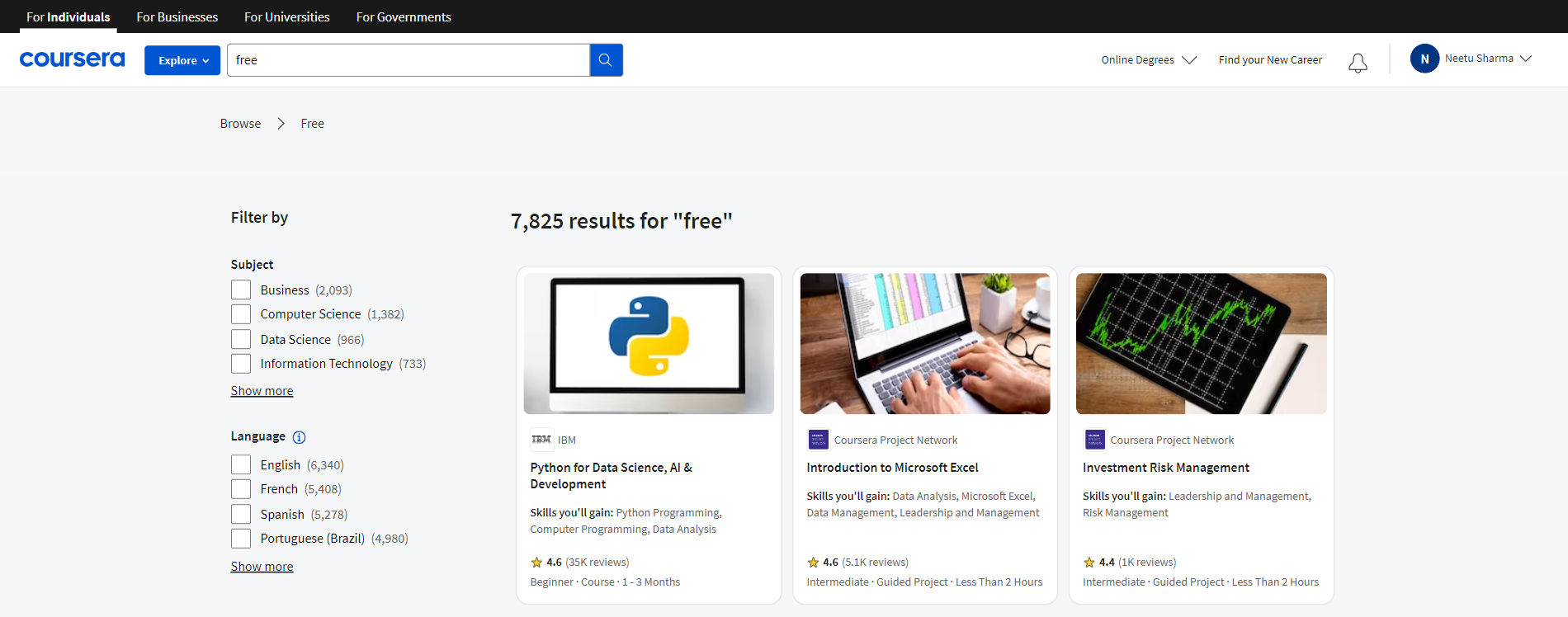
Coursera is another leading provider of eLearning content. With it, you get access to unlimited courses, both paid and free, to gain the latest skills.
It provides content in various formats, including video lectures, interactive quizzes, assignments, and readings.
Coursera partners with top universities and institutions worldwide to offer high-quality educational content. This makes it a trusted platform for online learning.
The types of content that Coursera provides cover different subjects and disciplines for different learning needs and career goals.
Coursera’s content is created and delivered by renowned instructors and experts in their respective fields. Learners can access the content at their own pace.
4. LinkedIn Learning
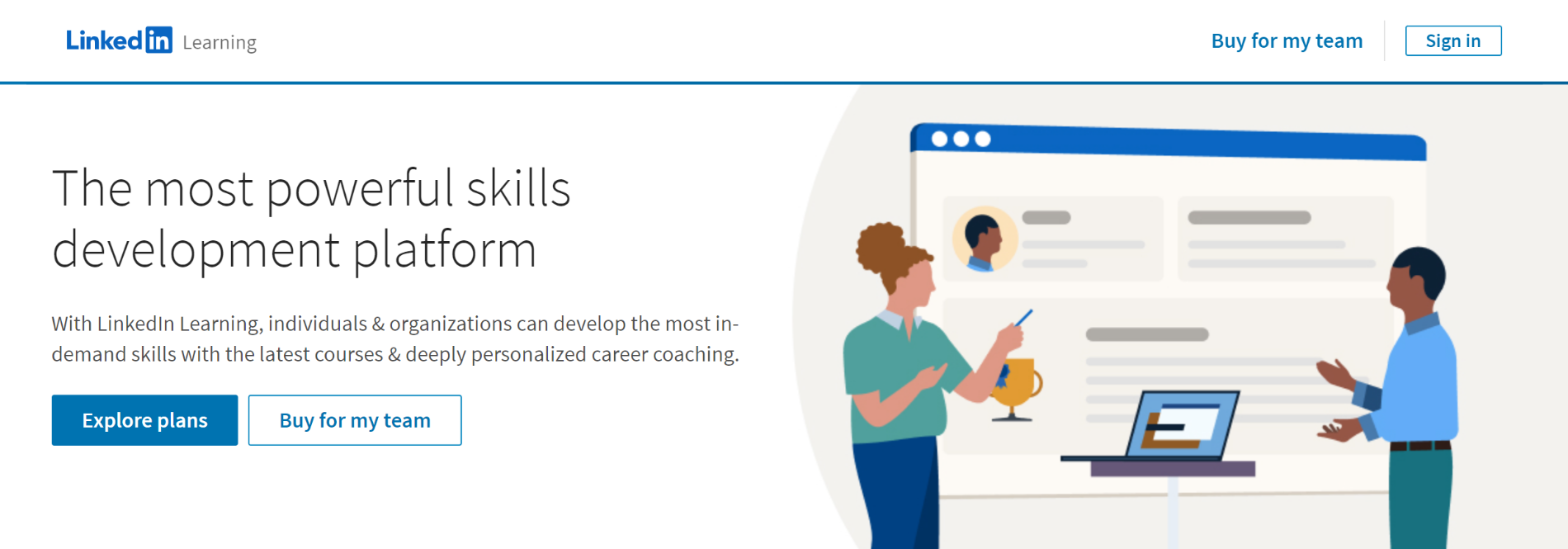
This eLearning content provider from the world’s largest professional networking and career development site can be an excellent source of content.
The platform offers a range of video courses taught by industry experts in software, creative, and business skills.
LinkedIn Learning is seamlessly integrated with LinkedIn’s professional networking platform. This integration enables users to easily add completed courses to their LinkedIn profiles and showcase their skills to potential employers and connections.
The platform is recognized for the quality of its content and selection of topics.
LinkedIn Learning offers personalized course recommendations to make it easier for learners to find relevant content that can help them progress in their careers.
5. Learning Pool
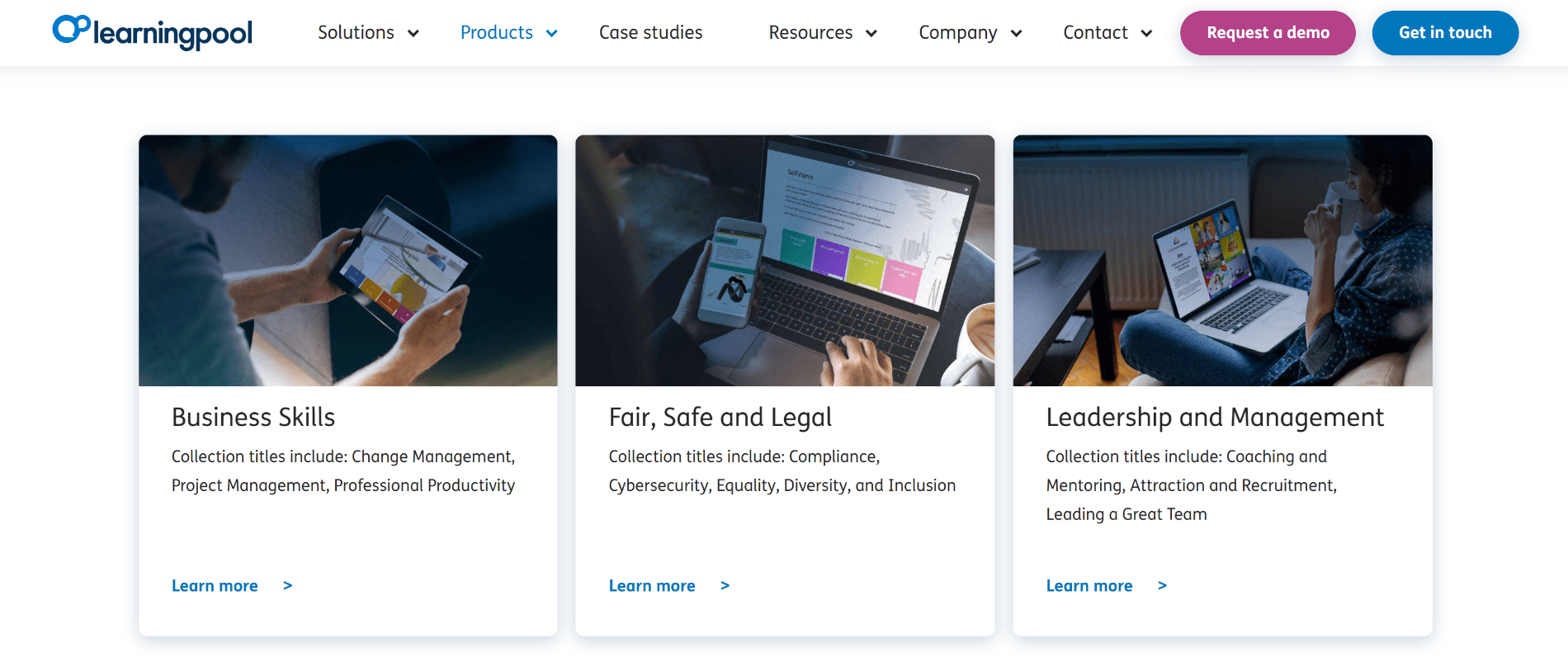
Learning Pool provides expert custom and off-the-shelf content to hit the ground running.
Its vast library of eLearning modules covers topics from compliance and health and safety to personal development and professional skills.
One of the key strengths of the provider is its ability to provide customizable content. Organizations can tailor the courses to fit their branding, specific learning objectives, or particular training scenarios.
Learning Pool also stays at the forefront of eLearning technology by incorporating the latest trends and innovations such as adaptive learning, gamification, and immersive technologies.
Its high-quality content is accredited by professional bodies. Beyond just providing content, Learning Pool offers extensive support and consultancy services.
No wonder, it has received numerous awards and recognitions from prestigious organizations within the eLearning industry.
Put These eLearning Content Examples Into Action!
The types of eLearning content you saw above represent the endless possibilities you can expect in online learning and training.
I understand that developing an eLearning plan takes time and effort. But once you decide on the type of content to be used, it is half the battle. You can then single-mindedly focus on how to make the most of that content type for the best experiences and learning outcomes.
If you’re considering a robust cloud LMS that supports various content types for online education or training, help is just around the corner.
Get started free today or request a personalized demo.
 Tips
Tips
We’d love to hear your tips & suggestions on this article!
Get Free eLearning Authoring Software — All Features, Forever.
We've helped 567 companies train 200,000+ employees. Create courses in under a minute with our AI LMS or use 200+ ready-made courses on compliance, harassment, DEI, onboarding, and more!
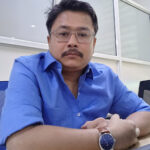
 We'd love your feedback!
We'd love your feedback! Thanks for your feedback!
Thanks for your feedback!


![What Are eLearning Templates? [Examples & How to Choose]](https://www.proprofstraining.com/blog/wp-content/uploads/2024/06/Feature_TM_What-Are-eLearning-Templates_-Examples-Benefits-How-to-Choose.png)
